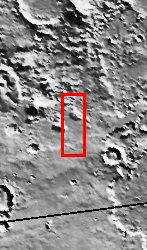
Released 20 November 2003
This image is located near the boundary between Syrtis Major and Isidis Planitia. The top of the image shows rough material that has eroded away from the lower portion of the image, revealing an underlying surface that has many small craters. It also reveals an ancient flow lobe that is barely discernible, crossing the southern part of the image (this flow lobe is much easier to see as a smooth region in the context image).
Image information: VIS instrument. Latitude 16.4, Longitude 77.9 East (282.1 West). 19 meter/pixel resolution.
Note: this THEMIS visual image has not been radiometrically nor geometrically calibrated for this preliminary release. An empirical correction has been performed to remove instrumental effects. A linear shift has been applied in the cross-track and down-track direction to approximate spacecraft and planetary motion. Fully calibrated and geometrically projected images will be released through the Planetary Data System in accordance with Project policies at a later time.
NASA's Jet Propulsion Laboratory manages the 2001 Mars Odyssey mission for NASA's Office of Space Science, Washington, D.C. The Thermal Emission Imaging System (THEMIS) was developed by Arizona State University, Tempe, in collaboration with Raytheon Santa Barbara Remote Sensing. The THEMIS investigation is led by Dr. Philip Christensen at Arizona State University. Lockheed Martin Astronautics, Denver, is the prime contractor for the Odyssey project, and developed and built the orbiter. Mission operations are conducted jointly from Lockheed Martin and from JPL, a division of the California Institute of Technology in Pasadena.

